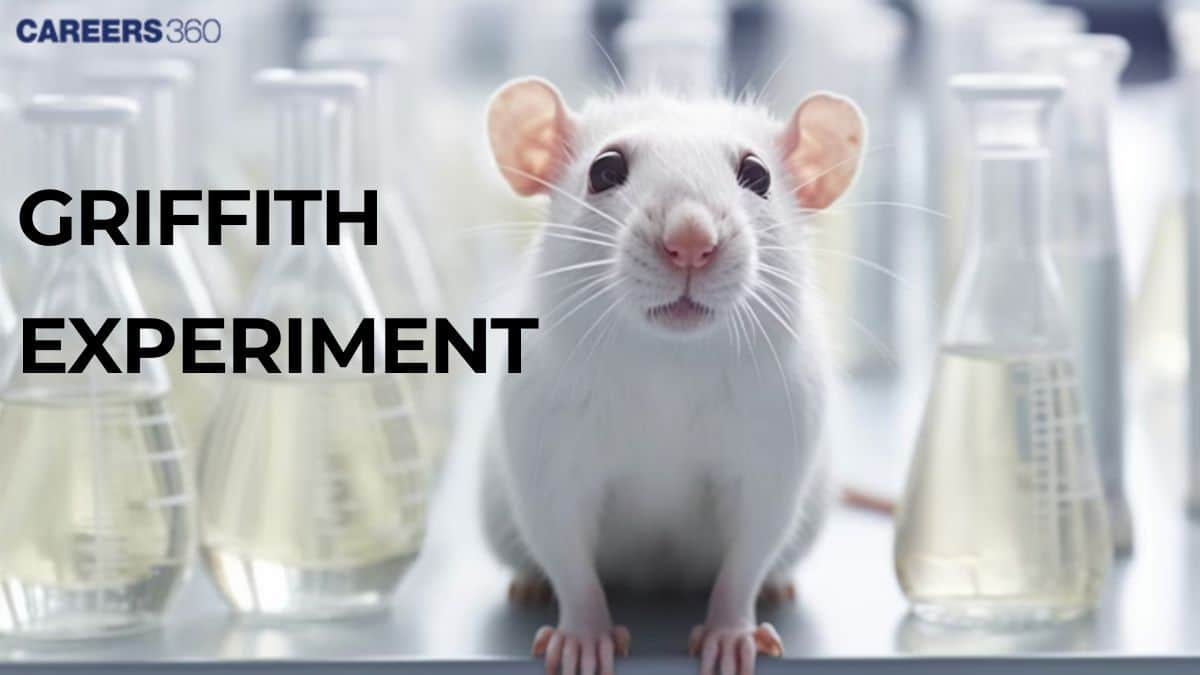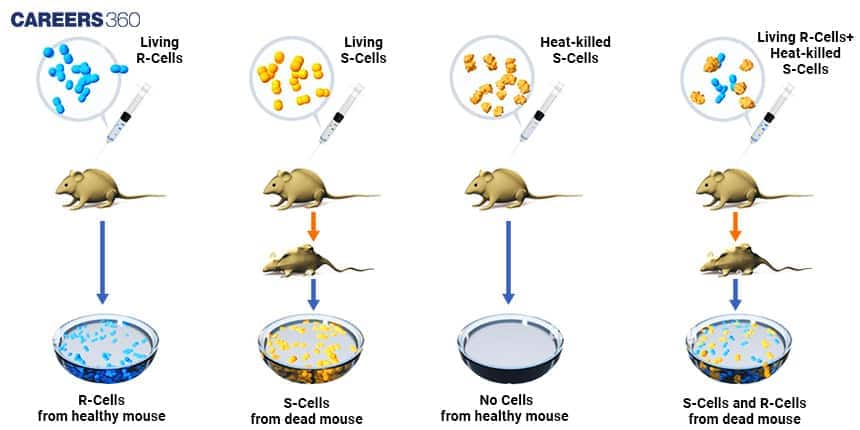Griffith Experiment and Transforming Principle: Introduction, Impacts and Diagram
Fredrick Griffith conducted the experiment which helped demonstrate the transfer of genetic information between bacteria. The experiment showed that a heat-killed virulent strain can transform a non-lethal strain of bacteria. Griffith named the material that was transferred the “transforming principle”.
This Story also Contains
- History of the Experiment
- Griffith's Experiment
- Diagram: Griffith Experiment
- Conclusion of Griffith's Experiment
- DNA as a Genetic Material
- Recommended video for Griffith's Experiment
- MCQs on Transforming Principle

His experiment involved the mix of living non-virulent bacteria with a heat-inactivated virulent form. The bacteria used are the Streptococcus pneumoniae, which shows two growth patterns. There were 2 culture plates, one of them had smooth, shiny colonies (S), while the other had rough colonies (R). The experiment proved that organisms can acquire new properties from their environment and from one another. Griffith Experiment and Transforming Principle is a topic of the chapter Molecular Basis of Inheritance in Biology.
History of the Experiment
The Griffith Experiment took place in 1928 when Frederick Griffith conducted a groundbreaking research study, the very first which suggested that genetic information could be transferred between organisms. This experiment was very crucial in the field of genetics, as it gave a concept of the "Transforming Principle" after which DNA was identified as the genetic material. This proved the fact that a factor obtained from dead bacteria could genetically transform the living bacteria and opened the doors for future discoveries within molecular biology.
Griffith's Experiment
The central focus of Griffith's experiment was based on locating the reason why particular strains of bacteria were causing pneumonia, whereas other strains were benign. In the current scenario, he was attempting to find out why certain strains of Streptococcus pneumoniae were causing diseases while others were non-pathogenic.
Basic Setup for the Experiment
Griffith inoculated mice with two strains of Streptococcus pneumoniae: the virulent S strain, exhibiting a smooth colony morphology due to a polysaccharide capsule, and the non-virulent R strain, exhibiting a rough colony morphology due to the absence of this capsule.
Kinds of Bacterial Strains Utilised
S Strain (virulent): The capsule is made of a polysaccharide, and that is what protects the S strain cell from the host immune system, making it pathogenic.
R Strain (non-virulent): It is non-pathogenic without the capsule, making it remain weak against the host immunity and immune system.
Step-by-Step Procedure
1. Injection of Live S Strain into Mice: The mice that were injected with live S strain bacteria succumbed to the disease of pneumonia, and live S strain bacteria were isolated from their bodies.
2. Injection of Live R Strain into Mice: Mice injected with live R strain bacteria survived, and no bacteria could be isolated from their bodies.
3. Injection of Heat-Killed S Strain into Mice: Mice injected with heat-killed S strain bacteria survived, indicating that the heat-killed bacteria were not virulent.
4. Injection of a Mixture of Heat-Killed S Strain and Live R Strain into Mice: Mice injected with this mixture died of pneumonia, and live S strain bacteria were isolated from their bodies. This suggested that some "transforming principle" from the heat-killed S strain had converted the R strain into a virulent form.
Results of Griffith's Experiment
Griffith found an interesting observation during this experiment: when the samples of non-virulent R strain bacteria were mixed with heat-killed S strain bacteria, something happened that transferred the information of the dead S strain bacteria to turn the live R strain bacteria into the virulent S strain. By this transformation, it was discovered that a "transforming principle" was present that carried the genetic information to turn the dead S strain into a live R strain.
Summary of the Outcomes from each Experimental Setup
Experimental Setup | Survival of Mice | Bacteria Isolated |
Live S strain injected | No | Live S strain bacteria |
Live R strain injected | Yes | None |
Heat-killed S strain injected | Yes | None |
A mixture of heat-killed S strain and live R strain was injected | No | Live S strain bacteria |
Diagram: Griffith Experiment
Given below is the diagrammatic representation of the Griffith Experiment, which has been explained in the previous topic.

Conclusion of Griffith's Experiment
The result that was most important from Griffith's experiment was the finding of the Transforming Principle. He conclusively demonstrated that an extract from dead, harmless S strain bacteria had transformed the remaining sample of non-virulent R strain bacteria into virulent S strain bacteria. This indicated that material which determined virulence was some sort of transmissible genetic material and hinted that inheritance might be exhibited on a molecular scale.
DNA as a Genetic Material
After the Griffith study, further research aimed to discover the nature of this Transforming Principle. This was followed by work in the 1940s by Oswald Avery, Colin MacLeod, and Maclyn McCarty, further proving that the Transforming Principle is DNA. Their experiments showed that pure DNA derived from S-strain bacteria, even when other cell components were removed, transformed R-strain bacteria into a virulent form. It was this major discovery that informed the world that DNA was the molecule that stored genetic information. The properties of the genetic material were yet to be discovered by further experiments.
Further work to show DNA as Genetic Material Hershey And Chase Experiment in 1952 on bacteriophages led to the same conclusions regarding DNA as the genetic material. They showed that when infection took place, it was the DNA from the phage, not the protein or RNA, which entered the bacterial cell and initiated the production of new phages. These two independent experiments thus defined DNA as the universal genetic material and changed our view of biology and heredity forever.
Recommended video for Griffith's Experiment
MCQs on Transforming Principle
Q1. Conjugation can be defined as
Option 1: Conjugation is the process of transfer of genetic material between two bacterias aligned together.
Option 2: This approach was given by Lederberg and Tatum.
Option 3: Lederberg and Tatum gave this idea that the F-factor can travel between E. coli cells.
Option 4: All of the Above
Correct answer: (4) All of the above
Explanation:
The process of exchanging genetic material between the bacteria is known as conjugation. One bacterium is the genetic material donor and another bacterium acts as the recipient. This approach was given by Lederberg and Tatum and the F- factor (Fertility factor) which is basically a DNA sequence present in the donor bacterium.
Hence, the correct option is (4) All of the above
Q2. Frederick Griffith performed an experiment where mice were killed when injected with a mixture of heat-killed S-type Streptococcus (HKS) and live R-type Streptococcus (LRS) but not with HKS or LRS separately. Mice were killed because
Option 1: Lipids from HKS made LRS virulent.
Option 2: RNA from HKS transformed LRS and made it virulent.
Option 3: Proteins from HKS made LRS virulent.
Option 4: DNA from HKS transformed LRS and made it virulent.
Correct answer: 4) DNA from HKS transformed LRS and made it virulent.
Explanation:
Transformation occurs when DNA is taken up by the R-strain from the dead S-strain.
Mice were killed when both the strains were mixed; DNA from HKS transformed to LRS and made it virulent. When the HKS bacteria were heat-killed, the DNA survived the heating process and transformed into LRS when mixed. The DNA of HKS has genes for smooth protective polysaccharide capsules. Due to the presence of these genes, LRS synthesizes a smooth polysaccharide coat becomes virulent, and kills the mice.
Hence, the correct answer is option 4) DNA from HKS transformed LRS and made it virulent.
Q3. The process in which the recombinant DNA is introduced into a recipient host cell is termed as________.
Option 1: Transformation
Option 2: Translation
Option 3: Transcription
Option 4: Ligation
Correct answer: 1) Transformation
Explanation:
Transformation is one of the steps in the process of recombinant DNA technology in which recombinant DNA is inserted into the recipient host cell.
Once the recombinant DNA is introduced into the host cell, it gets multiplied and under ideal conditions is expressed in the form of the manufactured protein.
Hence, the correct answer is option 1) Transformation
Also read-
Frequently Asked Questions (FAQs)
It was the first to suggest that bacteria could transfer genetic information through a "transforming principle," challenging the prevailing beliefs about genetic material at the time.
Griffith discovered the Transforming Principle, indicating that a substance could transfer genetic information between bacteria.
This experiment identified DNA as the Transforming Principle, proving that DNA is the material that carries genetic information.
It laid the groundwork for understanding the molecular basis of genetics and paved the way for the discovery of the DNA double helix structure.
Streptococcus pneumoniae strains: the virulent S strain and the non-virulent R strain.